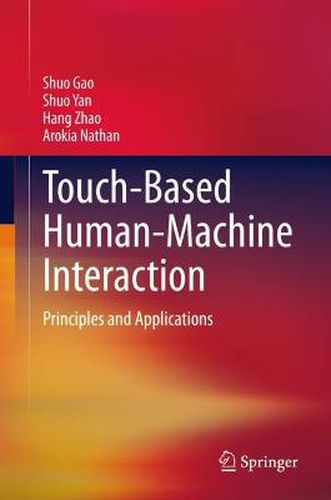Readings Newsletter
Become a Readings Member to make your shopping experience even easier.
Sign in or sign up for free!
You’re not far away from qualifying for FREE standard shipping within Australia
You’ve qualified for FREE standard shipping within Australia
The cart is loading…






This textbook presents a comprehensive treatment of touch technologies, explaining current mainstream and new contact/non-contact based human-machine interactivity (HMI) techniques, which are ubiquitous in modern electronic devices and allow machines to exchange information with users in an efficient and reliable manner. The book provides a detailed study of HMI working principles and practical product examples. Haptic, which has become essential for users to gain immersive experience, is also discussed. The book concludes with an overview of novel applications enabled by emerging technologies, such as advanced materials, virtual reality and machine learning, providing a roadmap for possible development trends for touch interactivities. The book can be used as a graduate text for students in display and touch interface technology courses in electrical and computer engineering, and a professional reference for researchers, practicing engineers, and product designers working in broad areas of engineering.
Helps students understand the working principles of current touch technologies; Offers design considerations for prototypes and products; Provides seamless connectivity between broad subject areas involved in HMI, including material science, microelectronic circuits, mechanical engineering, and digital signal processing.
$9.00 standard shipping within Australia
FREE standard shipping within Australia for orders over $100.00
Express & International shipping calculated at checkout
This textbook presents a comprehensive treatment of touch technologies, explaining current mainstream and new contact/non-contact based human-machine interactivity (HMI) techniques, which are ubiquitous in modern electronic devices and allow machines to exchange information with users in an efficient and reliable manner. The book provides a detailed study of HMI working principles and practical product examples. Haptic, which has become essential for users to gain immersive experience, is also discussed. The book concludes with an overview of novel applications enabled by emerging technologies, such as advanced materials, virtual reality and machine learning, providing a roadmap for possible development trends for touch interactivities. The book can be used as a graduate text for students in display and touch interface technology courses in electrical and computer engineering, and a professional reference for researchers, practicing engineers, and product designers working in broad areas of engineering.
Helps students understand the working principles of current touch technologies; Offers design considerations for prototypes and products; Provides seamless connectivity between broad subject areas involved in HMI, including material science, microelectronic circuits, mechanical engineering, and digital signal processing.